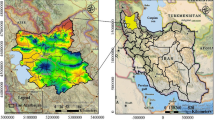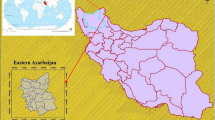Abstract
Asbestos mining has left a legacy of pollution in former mining areas that continues to negatively affect both the environment and local communities. In 2007, the Rehabilitation Prioritisation Index was developed as a scientific tool to indicate the preferred sequence for mine site rehabilitation and served as a departure point for the present investigation in which a database for the rehabilitation success of asbestos sites was developed. Broad-based quantitative and qualitative data, typically used for monitoring rehabilitation success, including amongst others, soil cover depth, physical and chemical soil properties, microbial activity, vegetation properties and small mammal abundance were analysed using multivariate statistics, specifically a redundancy analysis. The most representative model was subsequently selected for the classification of the rehabilitated sites. The multivariate analysis revealed those factors typically associated with rehabilitation success or failure, as well as essentials to be addressed. The feasibility of development of a rule set for rehabilitated site classification was firstly investigated using neural networks which also assisted in the selection of significant parameters. Results from the neural network approach were then used to guide parameter selection for the evolutionary algorithm software. The coordinate scores for the first two axes of the redundancy analysis served as targets for the evolutionary algorithms. Overall, a targeting match of 71 % for the first axis coordinates and 38 % for the second axis coordinates were obtained. Contributing parameters for the rule set included: Cl, K, pH, percentage organic carbon, Zn, NH4 and SO4 content of the sites.




Similar content being viewed by others
References
Berger KC (1968) Introductory soils. Macmillan, New York
Bergmann W (1992) Nutritional disorders of plants. development, visual and analytical diagnosis. Gustav Fischer Verlag, Jena
Bezuidenhout JJ, Du Plessis S, Van Ginkel C, Van Rensburg L (2008) Applicability of Ann models as a possible early warning tool for algal bloom prediction. In: Proceedings of Conference on Environmental Science and Technology. Houston
Coaltech (2007) Guidelines for the Rehabilitation of Mined Land. Chamber of Mines of South Africa
DeGrood SH, Claassen VP, Scow KM (2005) Microbial community composition on native and drastically disturbed serpentine soils. Soil Biol Biochem 37:1427–1435
Ellerly KS, Walker BH (1986) Growth characteristics of selected plant species on asbestos tailings from Msauli Mine, eastern Transvaal. S Afr J Bot 52(3):201–206
Emmanouil K, Kalliopi A, Dimitrios K, Evangelos A (2009) Asbestos pollution in an inactive mine: determination of asbestos fibers in the deposit tailings and water. J Hazard Mater 167:1080–1088
Fourie A, Brent AC (2006) A project-based mine closure model (MCM) for sustainable life cycle management. J Clean Prod 14:1085–1095
Giacomini F, Boerio V, Simona Polattini S, Tiepolo M, Tribuzio R, Zanetti A (2010) Evaluating asbestos fibre concentration in metaophiolites: a case study from the Voltri Massif and Sestri, Voltaggio Zone (Liguria, NW Italy). Environ Earth Sci 61:1621–1639
Hancock GR, Grabham MK, Martin P, Evans KG, Bollhöffer A (2006) A methodology for the assessment of rehabilitation success of post mining landscapes—sediment and radionuclide transport at the former Nabarlek uranium mine, Northern Territory, Australia. Sci Total Environ 354:103–116
Hart HP (1988) Asbestos in South Africa. J S Afr Inst Min Metall 88(6):185–198
Hossner LR, Hons FM (1992) Reclamation of Mine Tailings. In: Lal R, Stewart BA (eds) Soil Restoration. Advances in Soil Science, vol 17. Springer-Verlag, New York
Howlling GE (1937) Asbestos. Imperial Institute, London
Langer WH, Van Gosen BS, Meeker GP, Adams DT, Hoefen TM (2011) The dispersion of fibrous amphiboles by glacial processes in the area surrounding Libby, Montana, USA. Environ Earth Sci 64:157–168
Liebenberg D, Claassens S, Van Rensburg L (2012) A multidisciplinary approach for the assessment of rehabilitation at asbestos mines in South Africa. Environ Earth Sci 67(4):1237–1244
McCulloch J (2003) Asbestos mining In Southern Africa, 1893–2002. Int J Occup Environ Health 9:230–235
McCulloch J (2006) Saving the asbestos industry, 1960 to 2006. Public Health reports (974) 121(5):609–614
Meyer DR (1980) Nutritional problems associated with the establishments of vegetation on tailings from asbestos mines. Environmental pollution. Series A. Ecol biol 23(4):287–298
Moore TR, Zimmerman RC (1977) Establishment of vegetation on serpentine asbestos mine wastes, southeastern Quebec. Canada J Appl Ecol 14:589–599
Nel J (2006) The current risk of asbestos exposure to the citizens of the Prieska area, Northern Cape Province in South Africa. (Mini-dissertation). North-West University, Potchefstroom
Neri AC, Sánchez LE (2010) A procedure to evaluate environmental rehabilitation in limestone quarries. J Environ Manage 91:2225–2237
Parrot L (2011) Hybrid modelling of complex ecological systems for decision support: recent successes and future perspectives. Ecol Info 6:44–49
Pascual JA, Garcia C, Hernandez T, Moreno JL, Ros M (2000) Soil microbial activity as a biomarker of degradation and remediation processes. Soil Biol Biochem 32:1877–1883
Proctor J, Woodell ARJ (1975) The ecology of serpentine soils. In: Macfadyen A (ed) Advances in Ecological Research, vol 9. Academic Press, London, pp 256–385
Redco/Nemai Consortium (2008) Monitoring of previously rehabilitated asbestos sites in South Africa. Report prepared for the Department of Minerals and Energy. South Africa
Ros M, Hernandez MT, Gercia C (2003) Soil microbial activity after restoration of a semiarid soil by organic amendments. Soil Biol Biochem 35:463–469
Tate RL, Rogers BF (2002) Soil ecosystem properties, microbial diversity, and ecosystem assessments. In: Violante A, Huang PM, Bollag J-M, Gianfreda L (eds) Developments in soil science, vol 28B. Elsevier, New York, pp 79–93
Ter Braak CF and Smilauer P (1998) Canoco reference manual for user’s guide to Canoco community ordination, ver. 4. Microcompuer Power, New York
Thompson SA, Thompson GG, Withers PC (2008) Rehabilitation index for evaluating restoration of ecosystems using the reptile assemblage as the bio-indicator. Ecol Ind 8:530–549
Thorne W (1957) Zinc deficiency and its control. In: Norman AG (ed) Advances in agronomy. Academic Press Inc., New York, pp 31–66
Tordoff GM, Baker AJM, Willis AJ (2000) Current approaches to the revegetation and reclamation of metalliferous mine wastes. Chemosphere 41:219–228
Van der Walt IJ, De Klerk TC (2009) A model to determine nonoccupational human exposure to crocidolite asbestos fibers in the Northern Cape. South Africa. Phys Geogr 30(1):79–87
Van Rensburg L, Pistorius L (1998) An investigation into the problems associated with revegetating chrysotile tailings. S Afr J Plant Soil 15(4):130–140
Van Rensburg L, Maboeta MS, Morgental TL (2004) Rehabilitation of co-disposed diamond tailings: growth medium rectification procedures and indigenous grass establishment. Water Air Soil Pollut 154:101–113
Van Rensburg L, Claassens S, Bezuidenhout JJ, Jansen van Rensburg PJ (2008) Rehabilitation of asbestos mining waste: a Rehabilitation Prioritisation Index (RPI) for South Africa. Environ Geol 57(2):267–273
Van Wyk S (1994) ‘n Strategie vir die rehabilitasie van versteurde mynbougebiede in suidelike Afrika. (Proefskrif—PhD Omgewings wetenskappe). Potchefstroom Universiteit vir Christelike Hoer Onderwys. Suid-Afrika
Virta RL (2003) Worldwide Asbestos Supply and Consumption trends from 1900 through 2003. US Geological Survey Circular 1298. http://pubs.ugs.gov/circ/2006/1298/. Accessed Feb 2009
Welk A, Recknagel F, Cao H, Chan W, Talib A (2008) Rule-based agents for forecasting algal population dynamics in freshwater lakes discovered by hybrid evolutionary algorithms. Ecol Info 3:46–54
Wilson H, Recknagel F (2001) Towards a generic artificial neural network model for dynamic predictions of algal abundance in freshwater lakes. Ecol Model 146:69–84
Author information
Authors and Affiliations
Corresponding author
Rights and permissions
About this article
Cite this article
Bezuidenhout, J.J., Liebenberg, D., Claassens, S. et al. Application of evolutionary algorithms to develop a rule set for assessing the rehabilitation status of asbestos mines in South Africa. Environ Earth Sci 70, 3267–3275 (2013). https://doi.org/10.1007/s12665-013-2391-2
Received:
Accepted:
Published:
Issue Date:
DOI: https://doi.org/10.1007/s12665-013-2391-2




